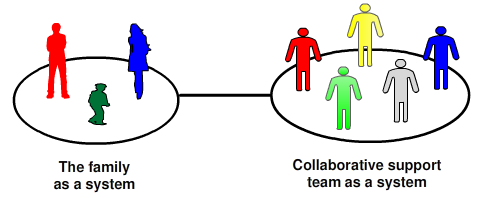It takes a system to change a system. I love that phrase. I came across it a couple weeks ago when reading British Columbia mediator/lawyer Nancy Cameron’s excellent book Collaborative Practice: Deepening the Dialogue. This book is a road map for family lawyers making the journey from traditional litigation to collaborative practice.
Now, I’m not a lawyer; yet, I do believe in the collaborative way, and that the collaborative inter-disciplinary approach to problem solving, advocated by Nancy in her book, has much to offer.
Systems thinking
Baking a cake is simple. Raising a child is complex. Complex problems require systems thinking; a belief that the component parts of a system can best be understood in the context of relationships with each other, and with other systems, rather than in isolation. Margaret Wheatley in Finding Our Way asks us to think of organizations as living systems. And, she asks us to think of organization more as a process, less as a structure. In living systems, everything is connected.
Collaborative support system
The Collaborative Family Law Group, based in Victoria, treats the family as a system. A family interacting with this group is served/supported by an inter-disciplinary team of professionals; including lawyers/mediators, divorce coach, financial advisor, and child specialist.
This collaborative team is a system unto itself; an alignment of diverse professionals, with similar values, undertaking coordinated work, applying appropriate process and resources.
As things get more complex.
Family break-up is one thing. What about when a larger community of people and interests are involved; e.g., dealing with urban core issues? What does the collaborative support team look like then?
Clay Shirky in his book: Here Comes Everybody: The Power of Organizing Without Organizations discusses how today’s social tools are dramatically improving our ability to share, cooperate, and act together”. I liked his book; full of insights. It’s given me some new ways of thinking about collaboration.
One of his ideas is around the role, and potential, of small teams, especially if they are linked together by connectors; those people on each team who provide a bridge to other teams (think Six Pixels of Separation).
Small teams align with innovative teams; see my post 39 Insights into the makeup of innovative teams
A collaborative support network comprised of small teams, with diverse membership, operating on shared vision and values, and leveraging a chaos/order framework (e.g., as described in my post about the Toronto-based Centre for Social Innovation’s constellation collaboration model), can accomplish much!
And to take it one step further (why not!), and if you’re fond of systems theory. Tom Atlee, founder of the Co-Intelligence Institute, yesterday, posed the question: Can we integrate systems thinking for social transformation?
What does your collaborative support system look like?
- Partners; e.g., Professionals-only? Volunteers? Third-party neutrals?
- Values; e.g., Social good? Do no harm? Triple-bottom-line? Interest-based dialogue?
- Relationships; e.g., with Partners? Clients? Other Stakeholders?
- Coordination; e.g., 3rd Party coordination? Planning? Financial? Conflict resolution?
- Governance; e.g., Form of Agreement? Membership?
- Process; e.g., Design? Variability from team to team?
Does your collaborative support system have a name?
If you enjoyed this post, please consider leaving a comment or subscribing to my blog. Thanks, Ben.



Speak Your Mind